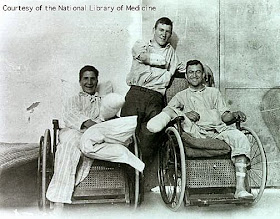A collection of disability-related articles and blog posts I read last week, but didn’t have a chance to link to or discuss. It’s an opportunity to catch up with some of the good stuff that’s out there, but doesn’t fit neatly into the week's “big stories.”
Here is this week’s list:
Patrick Sawer, The Telegraph - May 30, 2015
The article itself is a mess, (lots of bad disability terminology), but it is encouraging to see Stephen Hawking connect the dots between the supports he has enjoyed that helped him succeed, and the possible loss of support for disabled students today, due to expected budget cuts. People like to talk about what an amazing man he is to be as vital as he is with advanced ALS. By any measure he does have an extraordinary mind. But an important key to Hawking’s success is that he has had supportive help, funding, and technology that a lot of people find it hard or impossible to access. And something as simple as an election result can make it even harder.
Camilla Turner, The Telegraph - May 28, 2015
I doubt very much that the BBC will hire truly unqualified weather presenters any time soon, disability or no. As they told the Telegraph’s reporter, they are offering a training opportunity only, not a guaranteed job. The problem is that the network specified it’s for disabled people, and that they are offering the training as part of an organized effort to increase the number of disabled people on BBC TV shows. A few thoughts here:
- It would be more helpful to offer training and internships throughout the BBC’s national and regional news operations, both in front of the camera and behind, not just the tiny niche portion of being a “weather presenter.” There can’t be more than a few dozen in the whole of the United Kingdom.
- It might work better and be less controversial for the BBC to fund disabled student recruitment at UK university media departments.
- The tone of the ad is so flippant, it’s as if they are offering free carnival tickets to disabled people, not career training. By making it sound like a job people can just try out on a lark, it devalues the whole thing, like it’s one of those foolproof “work from home” schemes.
I am beginning to realize that straightforward ableism is often less painful to see than well-meaning but ham-fisted do-gooderism by non-disabled people. It makes one wonder if they really care whether their efforts actually work or not.
Haddayr Copley-Woods, Fiction, Essays, Geekery - May 29, 2015
This is a very good first-person account that tries to explain why disabled people sometimes get angry at people who are trying to be nice to us. For me, it’s all about tone of voice. I don’t think I am every really bothered by unsolicited, unwanted offers of help. It only becomes a “microaggression” when it becomes aggressive, defensive, or condescending.
Patrick Abboud, The Feed - May 27, 2015
It’s interesting to see that in Australia, if this article describes the situation accurately, the big barrier to getting out of nursing homes is lack of “affordable accessible housing.” That is often the problem here in the U.S., too, but here I think it’s even more of a problem getting personal care, reliably and in the right quantity. Nevertheless, this article describes very well just how wrong it is for disabled people to be forced by external circumstances … not by their disabilities … to live in nursing homes. I only have one quibble. The article keeps saying it’s terrible to make young people “live like an old person.” The thing is, it’s just as bad to make old people live like an old person, if that means shipping them off to a nursing home.
----------



























